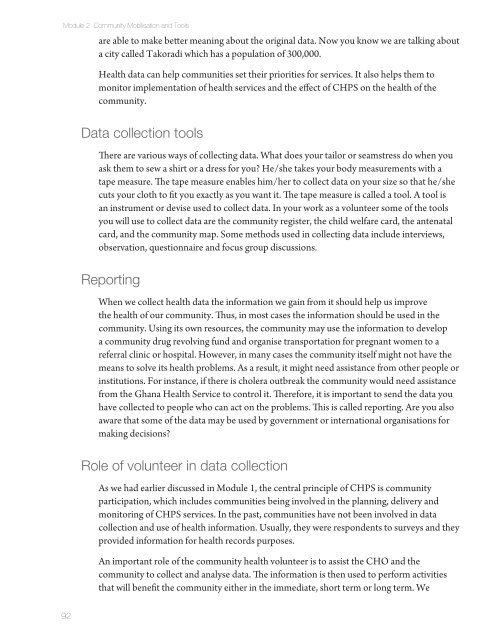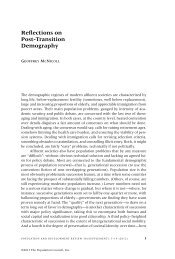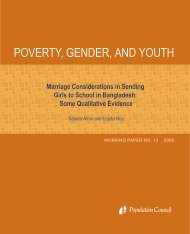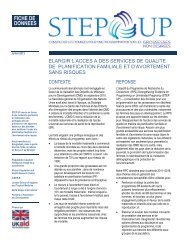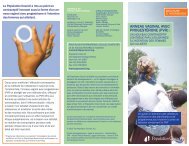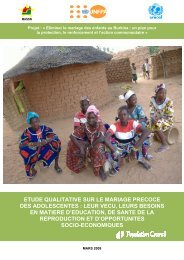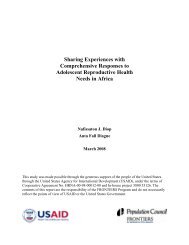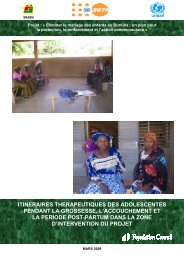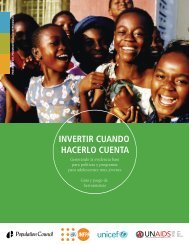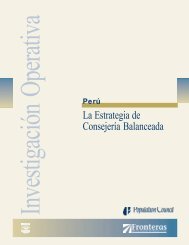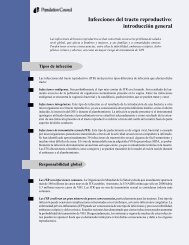Community Health Volunteer's Training Manual - Population Council
Community Health Volunteer's Training Manual - Population Council
Community Health Volunteer's Training Manual - Population Council
You also want an ePaper? Increase the reach of your titles
YUMPU automatically turns print PDFs into web optimized ePapers that Google loves.
Module 2 <strong>Community</strong> Mobilisation and Tools<br />
92<br />
are able to make better meaning about the original data. Now you know we are talking about<br />
a city called Takoradi which has a population of 300,000.<br />
<strong>Health</strong> data can help communities set their priorities for services. It also helps them to<br />
monitor implementation of health services and the effect of CHPS on the health of the<br />
community.<br />
Data collection tools<br />
There are various ways of collecting data. What does your tailor or seamstress do when you<br />
ask them to sew a shirt or a dress for you? He/she takes your body measurements with a<br />
tape measure. The tape measure enables him/her to collect data on your size so that he/she<br />
cuts your cloth to fit you exactly as you want it. The tape measure is called a tool. A tool is<br />
an instrument or devise used to collect data. In your work as a volunteer some of the tools<br />
you will use to collect data are the community register, the child welfare card, the antenatal<br />
card, and the community map. Some methods used in collecting data include interviews,<br />
observation, questionnaire and focus group discussions.<br />
Reporting<br />
When we collect health data the information we gain from it should help us improve<br />
the health of our community. Thus, in most cases the information should be used in the<br />
community. Using its own resources, the community may use the information to develop<br />
a community drug revolving fund and organise transportation for pregnant women to a<br />
referral clinic or hospital. However, in many cases the community itself might not have the<br />
means to solve its health problems. As a result, it might need assistance from other people or<br />
institutions. For instance, if there is cholera outbreak the community would need assistance<br />
from the Ghana <strong>Health</strong> Service to control it. Therefore, it is important to send the data you<br />
have collected to people who can act on the problems. This is called reporting. Are you also<br />
aware that some of the data may be used by government or international organisations for<br />
making decisions?<br />
Role of volunteer in data collection<br />
As we had earlier discussed in Module 1, the central principle of CHPS is community<br />
participation, which includes communities being involved in the planning, delivery and<br />
monitoring of CHPS services. In the past, communities have not been involved in data<br />
collection and use of health information. Usually, they were respondents to surveys and they<br />
provided information for health records purposes.<br />
An important role of the community health volunteer is to assist the CHO and the<br />
community to collect and analyse data. The information is then used to perform activities<br />
that will benefit the community either in the immediate, short term or long term. We


